The owner of Inside/Out Showrooms, looks at outdoor furniture design trends,
usage and best practices for selling to the higher-end interior design
market.
Catherine Trevigne grew up in Scottsdale, Arizona, loving outdoor life but
not necessarily outdoor furniture. Catherine Trevigne grew up in Scottsdale,
Arizona, loving outdoor life but not necessarily outdoor furniture. After
working as a rep for a cosmetics firm for a number of years, she decided she
needed to get a job that didn’t involve much traveling.
“I loved sales, working with, and training people,” she explained, “but I
got tired of being on the road and missing holidays with my family.”
In the early 1980s, a rep for Tropitone and Veneman, Ken Haddix, decided
there was a need for a local showroom to showcase Tropitone products to
Arizona’s design community. “At the time, said Trevigne, “outdoor furniture
was known for its PVC construction and banana fold-up chaises. The Tropitone
line, in contrast, was innovative and considered crazy expensive.
“We babysit their projects and make sure everything gets delivered in good
order and on time. We also inspect, repair and, when necessary, handle
warranty claims.”
“In 1994, Haddix hired me to manage the office and accounting. At the time,
we had a group of salespeople who were highly focused on making sales but
not necessarily a profit. My job included keeping track of their sales and
profits.
“I loved the business, learned all about it, started working with clients
and never left. Eventually, I purchased the company.” By then, Inside/Out
Showrooms, Inc. had become a destination where interior designers could find
everything from higher-end contemporary classics to elegant traditional
designs. It’s the only to-the-trade showroom exclusively featuring casual
furniture, fabrics and accessories in the Southwest.
Working With Designers
As the profile of the interior design community has risen in recent years,
furniture brands and furniture shows like High Point and Las Vegas have
become much more welcoming to designers. Trevigne believes that doesn’t
lessen the importance of local to-the-trade showrooms.
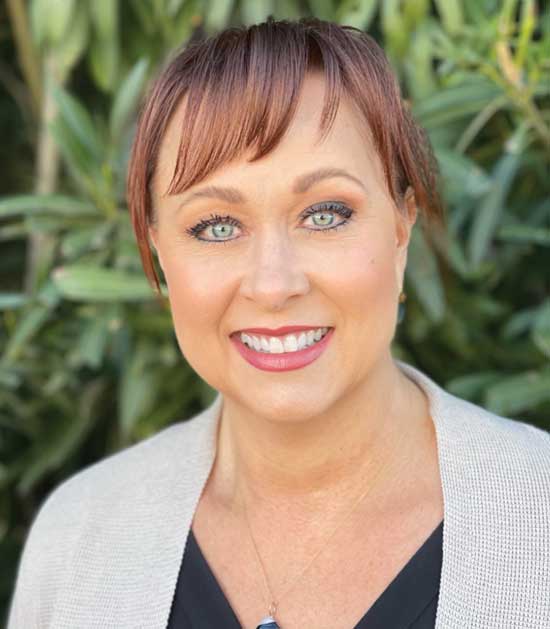
“Local interior design communities benefit from trade showrooms that
have the expertise to help designers become more familiar with the
features and benefits of outdoor brands.” -Catherine Trevigne Owner of Inside/Out Showrooms, Inc.
“Local interior design communities benefit from trade showrooms that have
the expertise to help designers become more familiar with the features and
benefits of outdoor brands. Showrooms like ours provide a controlled
environment where their clients can touch and feel comfort and quality. We
also take the pressure off designers who otherwise may get locked into
working with one or two vendors they met at a furniture show. Instead, they
can come to our showroom, get their trade discount, have more flexibility to
design exactly what they want, work with many vendors and not have to manage
logistics details. We babysit their projects and make sure everything gets
delivered in good order and on time. We also inspect, repair and, when
necessary, handle warranty claims.”
Why Inside/Out?
“Inside/Out is our showroom name as well as a concept that’s become more
universal. In places like Arizona, Hawaii and Florida, where people enjoy
outdoor living much of the year, the concept used to make more sense than in
North Dakota. However, designers nationwide have bought into the idea of
blending indoors and outdoors.
“Our selling season,” said Trevigne, “has expanded. Designers purchase for
clients who have multiple homes in other regions. We help them decide what
products will stand up to weather conditions in the Northeast versus a
vacation home in Scottsdale.”
Salespeople
“Our salespeople have design degrees, but they try not to interfere in the
decision-making process between a designer and their client unless
specifically asked to do so. Interior designers do their homework. They know
their clients’ needs, are familiar with their spaces and have design visions
for projects. Getting in the middle of that can cause a lot of trouble.”
Comfort and Wellness Trend
“Most of Inside/Out’s clients purchase transitional to contemporary styles,”
Trevigne continued. “However, we also sell traditional designs that
coordinate with homes in our area that have Southwest adobe or hacienda
feels and the white brick homes found in Scottsdale with transitional to
traditional architecture.
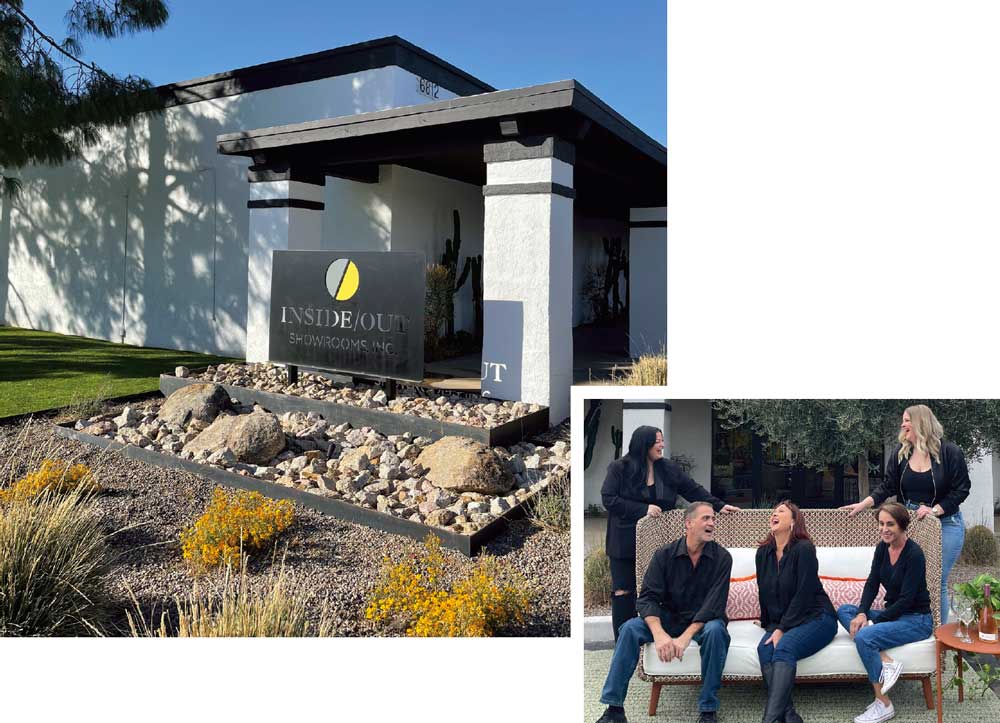
The Inside/Out Showroom has ample inside and outside space to show its
selections of designer-focused outdoor furnishings and host parties to
show off how homeowners might use their spaces. Some designers choose
to bring clients to the showroom. Others prefer to have products
transported to their locations for private client meetings. Pictured above are staff members (l-r): Karlee Prejean - Marketing & Social
Media Manager; Lee Trevigne, Accounting; Catherine Trevigne, Owner;
Cortney Solheim, Sales Manager; Sandy Hilton, Showroom Manager.
“Before the 2008 crash, our market was going full force into contemporary,
but then everything turned on a dime to traditional. I believe that was
because people were concerned that if they needed to sell their homes, they
would be easier to sell if they looked more traditional.
“Post-pandemic, everyone is all about making their homes comfortable,
welcoming places with a focus on wellness and healing. We recently hosted a
panel discussion event that included landscape architects, builders and
interior designers. They discussed the trend toward backyard areas that
include places to decompress and unwind. They said they are designing
sanctuary and meditation spaces that have a purpose beyond just being
beautiful. During the pandemic, many people learned to value their families
and respect their time so much more.
“Americans have always been people on the go. They skip vacation days, go to
work, and send their sick children to school. But there’s a growing
awareness that it’s not a healthy way to live.
“I don’t think we will ever shut down business here for an entire month as
Europeans do in August, but we’ve seen an awareness shift. Inside/Out’s
clients have shown more interest in purchasing furnishings to use in
sanctuary meditation gardens, including rugs and meditation cushions, than
ever before.
“The health and wellness trend can be seen across age and demographic
groups. The average outdoor furniture buyer on a budget is very different
from those we see in our world, but I believe it’s a societal trend.”
When asked if her in-showroom displays are heavily accessorized, Trevigne
responded, “We don’t display or sell a lot of tchotchkes like acrylicware or
dishes. There are other showrooms for that. We sell items that complete the
furniture collections on our sales floor and enhance the look of our
showroom.
“We work with a local artist who creates the colorful, abstract outdoor
paintings for our walls. The showroom is filled with live plants that lend
an outdoor feel. The floors are brick, and there are trees, so the showroom
looks much like a patio.”
Color, Fabrics and Textures
“Neutral palettes always remain first and foremost, while accent colors come
and go. Blues and denims never go out of style because they easily
coordinate with the sky and water. Oranges remain popular for their
inside-out appeal in the Southwest.
“The tables we sell day in and day out are mixed with many different chair
styles. A Pavilion table might be combined with Kingsley Bate wicker chairs
or Tropitone sling chairs. Finishes and materials look better when they’re
not all the same.”
“Outdoor furniture textures have followed trends in interior spaces. Rope
designs incorporated into outdoor furniture have become more interesting and
tactile. Nubbly boucle fabrics and textured finishes make outdoor furniture
items look like they can be used in a client’s living room. That’s what
everyone wants.”
Commenting on the increasing use of rope elements in outdoor furniture,
Trevigne observed, “At first, I thought it might be a fad, but it now
appears to be a style that’s here to stay. Brazilian manufacturer Tidelli
Outdoor Living, Belgium company Tribu and French producer Sifas have done
amazing jobs fabricating with marine rope for years. More recently, improved
access to rope from suppliers, including Sunbrella, has made it easier for
manufacturers to source suitable rope materials.
“I’m also seeing manufacturers put much more creativity into these designs.
I used to be able to purchase essentially the same chair from about six
different vendors. Nothing was interesting about that. But now, when I look
at a Sifas design incorporating rope, I instantly know it’s Sifas. The same
is true for other manufacturers we source from because of their attention to
how they weave their designs.
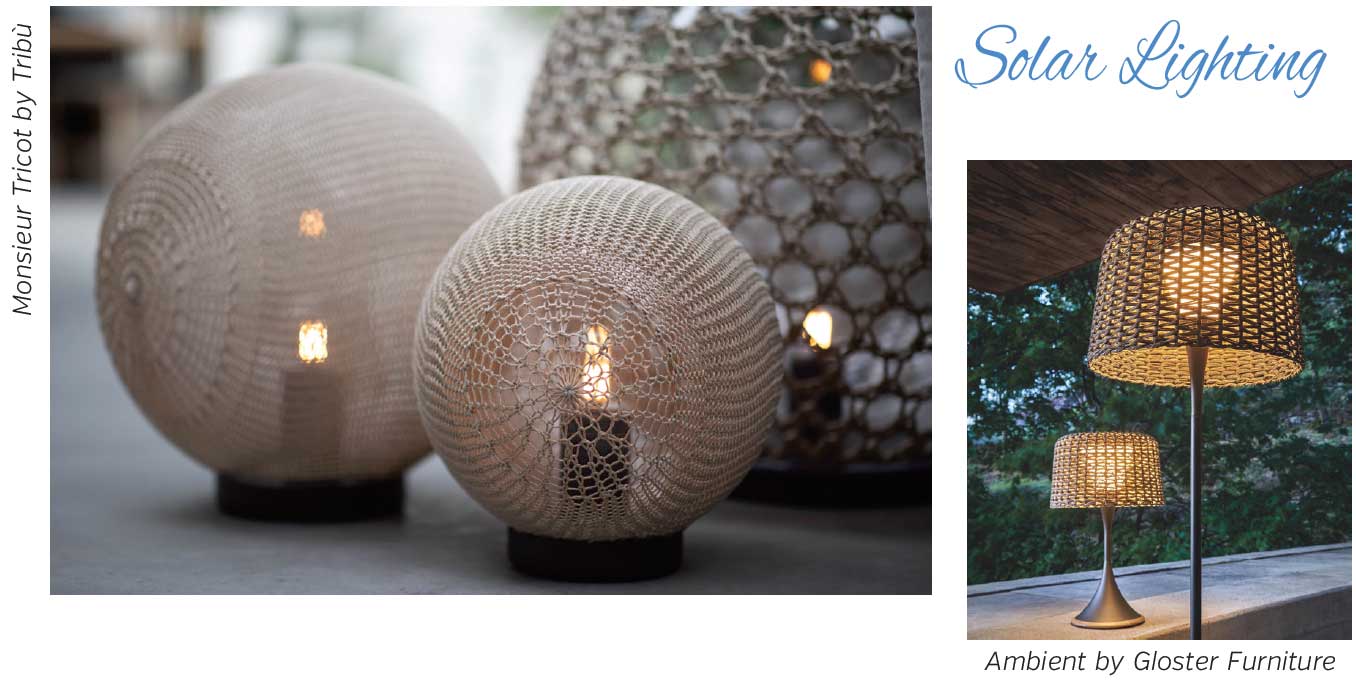
Trevigne noted that “solar lighting has advanced a lot in recent
years. Suppliers like Vibia and Les Jardin sell beautiful items. I
like what Gloster is doing in the category because it’s user-friendly,
adaptable and long-lasting.”
“We sell a ton of teak furniture. Whether they let it go grey depends on
personal preference. The most important thing retailers can do is bring up
the topic of teak maintenance with customers. At a minimum, teak furniture
must be cleaned of dirt, body oil and food. It’s also a good idea to sand it
slightly to remove rough grain and restore a smooth surface. Some people
love teak, but the thought of it not keeping its golden color breaks their
hearts. They may be better off choosing aluminum or a material that mimics
teak and gives that feel but avoids maintenance.
“Here in the Southwest, especially, the nubblier fabrics hold on to dust and
dirt more and break down quicker. In the Northeast, mold and mildew are a
bigger problem.
The designers we work with know that if a client purchases $30,000 worth of
outdoor furniture for their patio, they need to know how to maintain it. If
they aren’t willing to vacuum frequently and wash it off with soap and
water, it’s better to point them in a different direction. That’s especially
true for the many homes here in Arizona designed to have seamless living
rooms and patio spaces.”
“Nubbly boucle fabrics and textured finishes make outdoor furniture items
look like they can be used in a client’s living room. That’s what everyone
wants.”
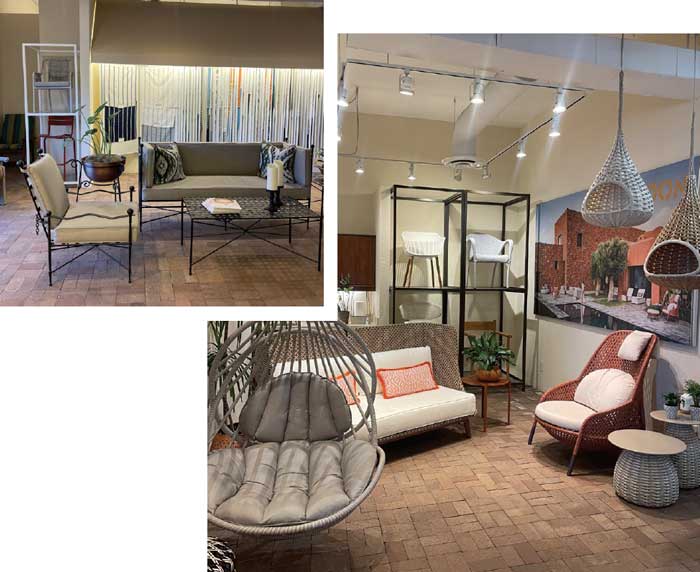
Inside/Out’s showroom features plants and some accessory items that
enhance the look of the showroom. Trevigne said she’s been searching
for more outdoor storage cabinets. “It’s an underserved category I’ve
been looking for,” she shared. “People want to put stuff away and
close it up without going back inside.”
Beyond Lounging and Dining
In many ways, outdoor spaces have evolved to mirror indoor spaces with work
areas, outdoor kitchens, and beds.
“This trend is going to keep growing. There are so many options,” Trevigne
observed. “We offer Tuuci, which makes covered cabana structures that can be
customized with a full bed or various bench configurations. We also
represent Dedon and Gloster, offering some of the most incredible daybeds. A
vast range of price points is available in the daybed category, making this
a specialty piece for anyone, granted they have the space.
“People are wise to create as much shade as possible, so the designers we
work with purchase lots of umbrellas. We sell classic styles that fit much
of the architecture here, such as Santa Barbara-style homes or brick homes
surrounded by lush, green landscapes, that call for a more traditional
umbrella. Designers also specify super contemporary architectural pieces,
like the Tuuci Stingray, that might not be a good fit outside a 1956
ranch-style home.”
Planters & Partitions: “During COVID,” Trevigne recalled, “restaurants
installed more outdoor open and semi-enclosed spaces that included
partitions. I think people liked that added privacy, and that idea caught on
in residential outdoor design.
“Planters that separate outdoor spaces are relatively easy to find in the
marketplace,” Trevigne noted. “For example, Tuuci makes beautiful planters
with screens.”
“I think we will see outdoor storage come back as a strong category that
allows our interior design customers and outdoor furniture consumers, more
generally, to complete their outdoor spaces.”
Storage & Cabinets: A product category that’s not easy to find is outdoor
storage. Trevigne believes there will be a big market for outdoor storage
units and cabinets. “It’s an underserved category I’ve been looking for,”
she shared. “People want to put stuff away and close it up without going
back inside. I recall that Kingsley Bate discontinued a beautiful, big teak
cabinet a few years ago. I think we will see outdoor storage come back as a
strong category that allows our interior design customers and outdoor
furniture consumers, more generally, to complete their outdoor spaces.”
Electronics: “In 1970, my dad bought a small portable TV to watch sports on
our porch. Now, people have 72-inch TVs and complete music systems on their
patios, built-in fireplaces and full kitchens. They want to live in their
outdoor rooms, do everything they can do inside, and more.”
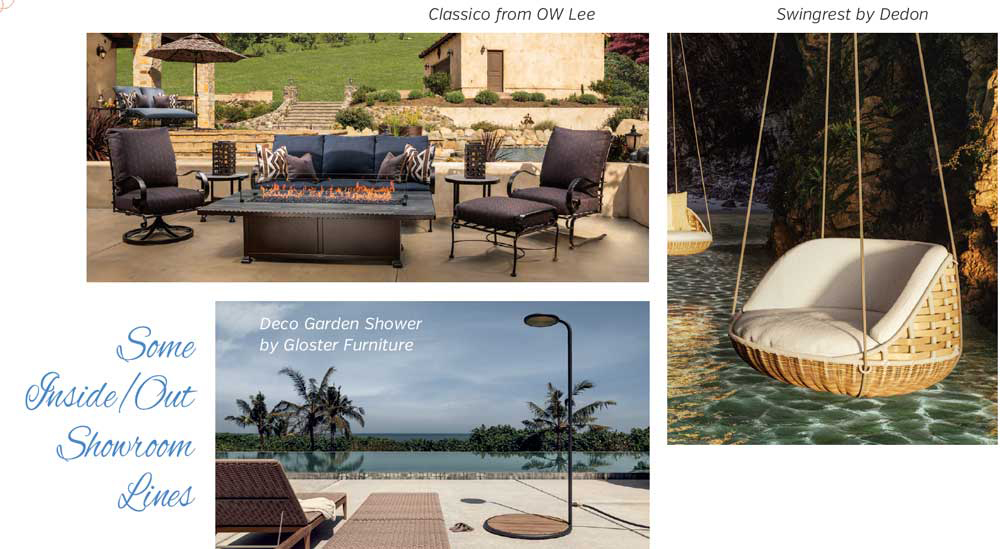
In-Store Display
In addition to inside displays, Inside/Out uses portions of its parking lot
to showcase furniture, see how it ages and perform product demonstrations.
“Right now, we are showing a Gloster bar table with a teak top, plus Dedon
and Lane designs,” Trevigne continued. “We also display Tropitone pieces to
show customers what their tight upholstery will look like in full sun, how
it weathers and how they can clean it. It’s also a great way to show fabrics
and finishes in natural light.
“And we love to have parties here to show how clients might use their
spaces. Sometimes, designers bring clients with them. However, others don’t
want their clients to get distracted at our location. If they prefer, we
bring the product to their locations for client meetings.”
Mixing and Matching
Trevigne recalled when everything Inside/Out sold matched. “About 20 years
ago, that started to change. There was a time when, if we weren’t selling OW
Lee’s Classico with its textured taupe finish and Sunbrella taupe rib
fabric, we weren’t selling anything. It was the predominant Arizona look
that everybody gravitated towards. Brown Jordan and Woodard had versions of
it with strapped, crisscross looks and rolled arms. Everything matched.
“There was a time when, if we weren’t selling OW Lee’s Classico with its
textured taupe finish and Sunbrella taupe rib fabric, we weren’t selling
anything. It was the predominant Arizona look.”
Conclusion
“Now, mixed materials have exploded, including amazing ceramic tops, teak
tops, and aluminum legs. Castelle does faux slate, and Pavilion just
introduced a new ceramic top dining table that expands to 120 inches. The
tables we sell day in and day out are mixed with many different chair
styles. A Pavilion table might be combined with Kingsley Bate wicker chairs
or Tropitone sling chairs. Finishes and materials look better when they’re
not all the same.”
Furniture World asked Trevigne if her clients are concerned about
sustainability.
She replied, “They don’t ask about it specifically, but since we deal with
the high-end, the furniture we sell is heirloom quality that isn’t
disposable. People who purchase a 16-foot cantilever umbrella will return to
buy a cover from us 10 years later and again 10 years after that.
“People feel good about buying Sunbrella fabrics that are made with recycled
fibers. Some outdoor furniture is made from recycled aluminum, but that’s
not always an option. If it’s cast, it needs to be made from virgin
aluminum.
“It would be great to say a piece of outdoor furniture is fully recyclable,
but right now, since it’s impractical to find recycling centers, those are
just words. Some companies are investing in using more recycled materials. I
recently visited Tribu Furniture in Belgium for a training session. They’ve
put a lot of effort into using recycled materials.”
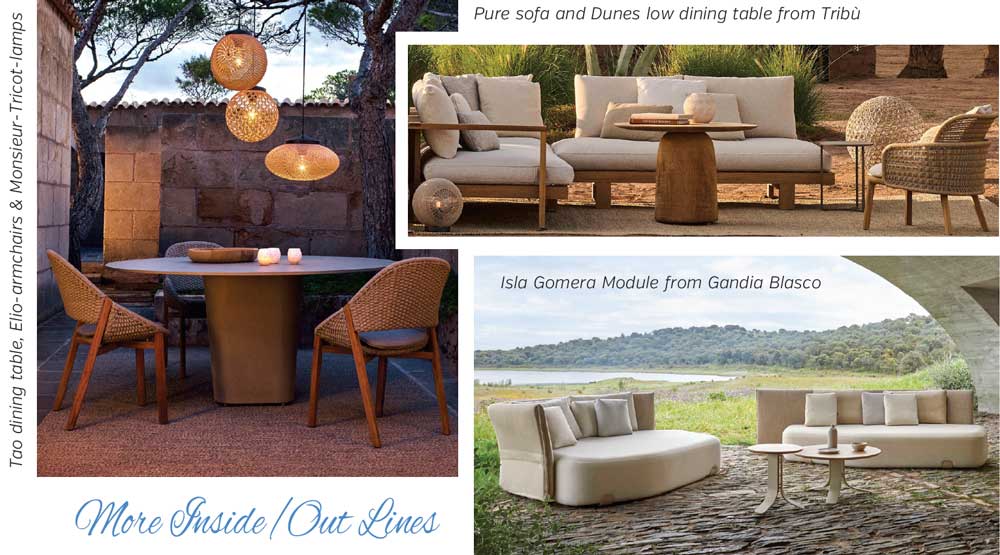
Outdoor Lighting
“When asked about outdoor lighting,” Trevigne said, “It’s not my area of
expertise, so I try to stay in my lane. Solar lighting has advanced a lot in
recent years. Suppliers like Vibia and Les Jardin sell beautiful items. I
like what Gloster is doing in the category because it’s user-friendly,
adaptable and long-lasting.”
“A vast range of price points is available in the daybed category, making
this a specialty piece for anyone, granted they have the space.”
Advice for Retailers
When asked to share her thoughts about best practices for furniture
retailers who don’t often sell $30,000 to $40,000 worth of outdoor furniture
to a customer, Trevigne offered the following suggestions.
“People walk into our showroom from time to time and relate a terrible
experience they had with their patio furniture. They believe that none of it
lasts because something they were sold was wrong for them. I always ask a
ton of questions to figure out where the train went off the tracks. Usually,
it was because the furniture was not well matched to its surroundings or the
end user didn’t do required maintenance. If a customer who loves the color
of an oiled teak table is unlikely to oil it frequently, it can make sense
not to sell them a teak table in the first place!”
“While retail salespeople come and go, I think that most retailers can
benefit from an increased focus on retail education in the outdoor category.
Without that, salespeople can’t sell products correctly. They need to be
able to relate what customers should expect from certain materials placed
outdoors to the necessity of proper maintenance. Without that focus, it
reflects poorly on stores and the entire outdoor furniture industry.
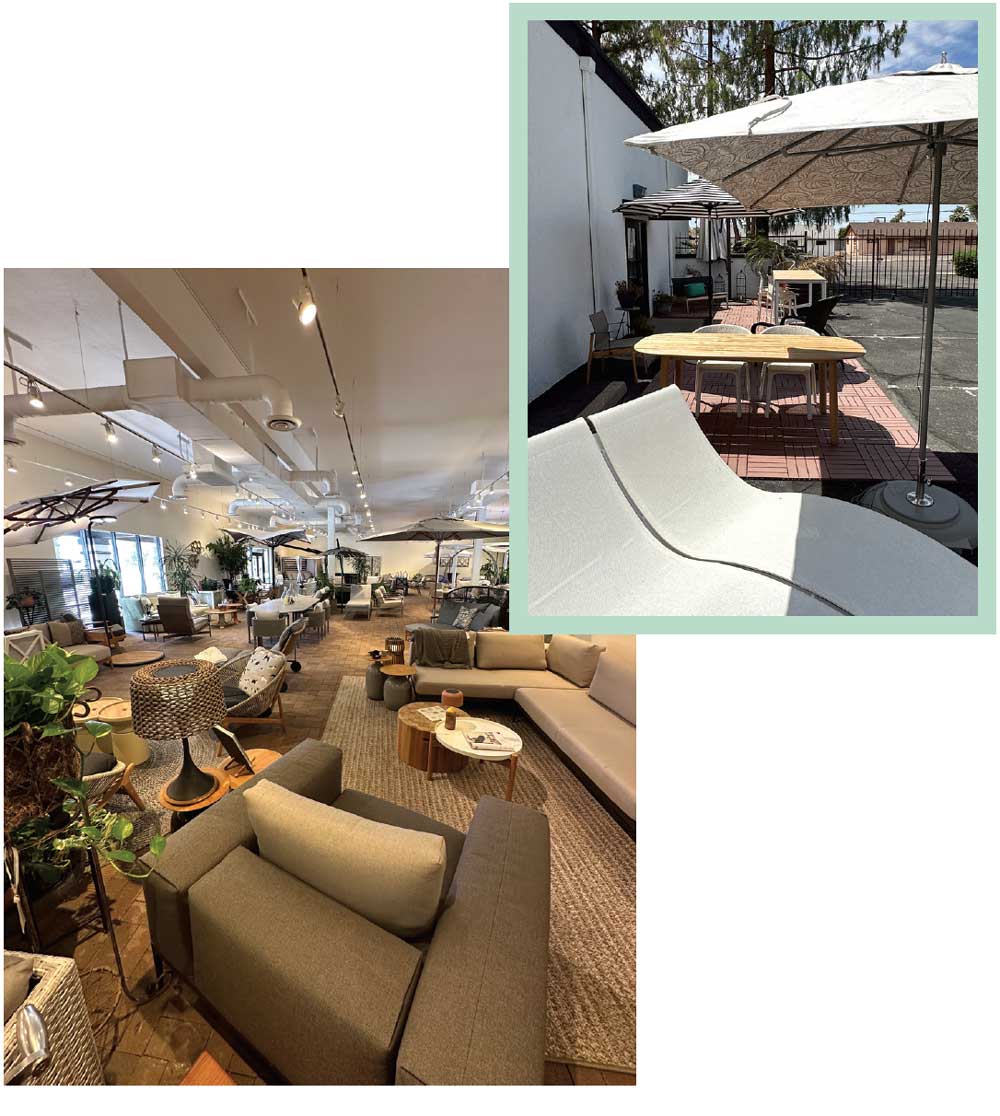
Inside/Out Showrooms uses portions of its parking lot (above) to
showcase furniture and do product demonstrations. The showroom (left)
has brick floors, live plants and trees to create a patio-like feel.